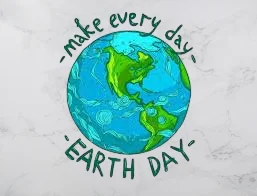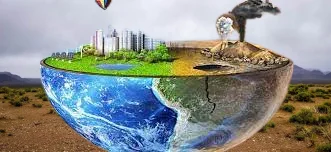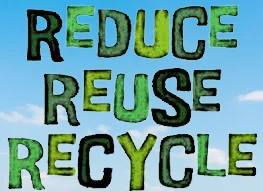Earth Day is celebrated globally on 22nd April. Earth Day is an annual event. Every year Earth Day is celebrated with a specific theme. This year for 2023, the official theme of Earth Day is Invest In Our Planet. Today, Earth Day is widely recognized as the largest secular observance in the world, marked by more than a billion people every year as a day of action to change human behavior and create global, national and local policy changes.
Earth Day
Earth Day is celebrated to show or demonstrate support for environmental protection. Every year on 22nd April, more than a Billion people in 193 countries celebrate this day to protect the planet from things like pollution and deforestation. People across the countries with the support of different Government and private organizations specifically with the support of many Non Government Organizations (NGOs) participate in awareness activities and spread awareness by picking up litters, planting trees, participate in cleanliness drives and many more such activities.

History of Earth Day
The first Earth Day was celebrated on April 22, 1970. The seeds of an Earth Day celebration dates back to 1969 in the United States.
Unocal Company
Union Oil Company of California, and its holding company Unocal Corporation, together known as Unocal was a major petroleum explorer and marketer in the late 19th century, through the 20th century, and into the early 21st century. It was headquartered in El Segundo, California, USA.
On 28th January, 1969, Union Oil company was drilling a well for extracting oil at 10 km off the coast of Santa Barbara, California. The well blew out ( A blowout is the uncontrolled release of crude oil and/or natural gas from an oil well or gas well after pressure control systems failed). As a result of this blow out more than three million gallons of oil spilled, killing more than 10,000 seabirds, dolphins, seals, and sea lions. As a reaction to this disaster, activists were mobilized to create environmental regulation, environmental education, and Earth Day.
On the first anniversary of the oil blowout, January 28, 1970, Environmental Rights Day was created, and the Declaration of Environmental Rights was read. The seeds that grew into the first Earth Day were planted by Wisconsin Senator Gaylord Nelson. An ardent conservationist and former two-term governor of Wisconsin, Nelson had long sought ways to increase the potency of the environment as a political issue.
The first Earth Day was celebrated in 1970, when a United States senator from Wisconsin organized a national demonstration to raise awareness about environmental issues. Rallies took place across the country and, by the end of the year, the U.S. government had created the Environmental Protection Agency. In 1990, Earth Day went global, mobilizing 200 million people in 141 countries and lifting environmental issues onto the world stage. By 1990, Earth Day was an event celebrated by more than 141 countries around the globe.
Earth Day 1990 gave a huge boost to recycling efforts worldwide and helped pave the way for the 1992 United Nations Earth Summit in Rio de Janeiro. It also prompted President Bill Clinton to award Senator Nelson the Presidential Medal of Freedom — the highest honor given to civilians in the United States — for his role as Earth Day founder.
Google’s first Earth Day doodle was released in 2001. In 2020, the 50th anniversary of Earth Day was celebrated including activities such as the Great Global CleanUp, Citizen Science, Advocacy, Education, and art.
Biggest Environmental Problems as on 2023
As per earth.org ( EARTHDAY.ORG’s mission is to diversify, educate and activate the environmental movement worldwide. Growing out of the first Earth Day in 1970, EARTHDAY.ORG is the world’s largest recruiter to the environmental movement, working with more than 150,000 partners in over 192 countries to drive positive action for our planet ) report below are some of the biggest environmental problems of our lifetime, from deforestation and biodiversity loss to food waste and fast fashion. On Earth Day let us know the reasons causing environmental problems and be united to erase these to make this earth a beautiful place to live in.

1. Global Warming From Fossil Fuels
Increased emissions of greenhouse gases ( CO2 ) have led to a rapid and steady increase in global temperatures, which in turn is causing catastrophic events all over the world – from Australia and the US experiencing some of the most devastating bushfire seasons ever recorded, locusts swarming across parts of Africa, the Middle East and Asia, decimating crops, and a heatwave in Antarctica that saw temperatures rise above 20 degrees for the first time.
Scientists are constantly warning that the planet has crossed a series of tipping points that could have catastrophic consequences, such as advancing permafrost melt in Arctic regions, the Greenland ice sheet melting at an unprecedented rate, accelerating sixth mass extinction, and increasing deforestation in the Amazon rainforest, just to name a few.
The climate crisis is causing tropical storms and other weather events such as hurricanes, heatwaves and flooding to be more intense and frequent than seen before. However, even if all greenhouse gas emissions were halted immediately, global temperatures would continue to rise in the coming years. That is why it is absolutely imperative that we start now to drastically reduce greenhouse gas emissions, invest in renewable energy sources, and phase our fossil fuels as fast as possible.
2. Food Waste
A third of the food intended for human consumption – around 1.3 billion tons – is wasted or lost. This is enough to feed 3 billion people. Food waste and loss account for a third of greenhouse gas emissions annually Food waste and loss occurs at different stages in developing and developed countries; in developing countries, 40% of food waste occurs at the post-harvest and processing levels, while in developed countries, 40% of food waste occurs at the retail and consumer levels.
3. Biodiversity Loss
The past 50 years have seen a rapid growth of human consumption, population, global trade and urbanisation, resulting in humanity using more of the Earth’s resources than it can replenish naturally.
A recent WWF report found that the population sizes of mammals, fish, birds, reptiles and amphibians have experienced a decline of an average of 68% between 1970 and 2016. The report attributes this biodiversity loss to a variety of factors, but mainly land-use change, particularly the conversion of habitats, like forests, grasslands and mangroves, into agricultural systems. Animals such as pangolins, sharks and seahorses are significantly affected by the illegal wildlife trade, and pangolins are critically endangered because of it.
More than 500 species of land animals are on the brink of extinction and are likely to be lost within 20 years.
4. Plastic Pollution/Waste Management
The world generates 300 million tonnes of plastic waste each year. currently, roughly 14 million tons of plastic make their way into the oceans every year, harming wildlife habitats and the animals that live in them. The research found that if no action is taken, the plastic crisis will grow to 29 million metric tons per year by 2040. If we include microplastics into this, the cumulative amount of plastic in the ocean could reach 600 million tons by 2040.
Shockingly, National Geographic found that 91% of all plastic that has ever been made is not recycled, representing not only one of the biggest environmental problems of our lifetime, but another massive market failure. Considering that plastic takes 400 years to decompose, it will be many generations until it ceases to exist.
5. Deforestation
By the year 2030, the planet might have only 10% of its forests; if deforestation isn’t stopped, they could all be gone in less than 100 years.
The three countries experiencing the highest levels of deforestation are Brazil, the Democratic Republic of Congo and Indonesia. The Amazon, the world’s largest rainforest – spanning 6.9 million square kilometres (2.72 million square miles) and covering around 40% of the South American continent – is also one of the most biologically diverse ecosystems and is home to about three million species of plants and animals.
Despite efforts to protect forest land, legal deforestation is still rampant, and about a third of global tropical deforestation occurs in Brazil’s Amazon forest, amounting to 1.5 million hectares each year.
The world has been chopping down 10 million hectares of trees every year to make space to grow crops and livestock, and to produce materials such as paper. Agriculture is the leading cause of deforestation, another one of the biggest environmental problems appearing on this list.
Land is cleared to raise livestock or to plant other crops that are sold, such as sugar cane and palm oil. Besides for carbon sequestration, forests help to prevent soil erosion, because the tree roots bind the soil and prevent it from washing away, which also prevents landslides.
6. Air Pollution
One of the biggest environmental problems today is outdoor air pollution. Data from the World Health Organization (WHO) shows that an estimated 4.2 to 7 million people die from air pollution worldwide every year and that nine out of 10 people breathe air that contains high levels of pollutants.
In Africa, 258,000 people died as a result of outdoor air pollution in 2017, up from 164,000 in 1990, according to UNICEF. Causes of air pollution mostly comes from industrial sources and motor vehicles, as well as emissions from burning biomass and poor air quality due to dust storms.
Vehicular emissions, industrial waste, smoke from cooking, the construction sector, crop burning, and power generation are among the biggest sources of air pollution.
The largest contributors are fossil-fuel-powered vehicles (cars, trucks, aircraft, ships, etc.) and coal- or oil-burning power plants and factories.
Air pollution has been proven to contribute to health problems including breathing issues, worsening of asthma, and even congenital disabilities.
According to Pure Earth, toxic pollution is among the leading risk factors for non-communicable diseases globally. Non-communicable diseases account for 72% of all deaths, 16% of which are caused by toxic pollution. Toxic pollution is responsible for 22% of all cardiovascular disease, 25% of stroke deaths, 40% of lung cancer deaths, and 53% of deaths from chronic obstructive pulmonary disease.
As per World Health Organization (WHO), which indicates that air pollution causes 7 million premature deaths every year. 91-99% of the world’s population lives in places where air quality exceeds WHO recommended guidelines.
7. Water Pollution
Among the most pressing environmental issues in the world is Water Pollution. Waterways have become extremely polluted, with around 70% of surface water estimated to be unfit for consumption. Illegal dumping of raw sewage, silt, and garbage into rivers and lakes are some of the reasons.
Besides affecting humans, water pollution also damages crops, as infectious bacteria and diseases in the water used for irrigation prevent them from growing. Inevitably, freshwater biodiversity is also severely damaged.
8. Agriculture
Studies have shown that the global food system is responsible for up to one third of all human-caused greenhouse gas emissions, of which 30% comes from livestock and fisheries. Crop production releases greenhouse gases such as nitrous oxide through the use of fertilisers. 60% of the world’s agricultural area is dedicated to cattle ranching, although it only makes up 24% of global meat consumption.
Scientists and environmentalists have continuously warned that we need to rethink our current food system; switching to a more plant-based diet would dramatically reduce the carbon footprint of the conventional agriculture industry.
9. Fast Fashion and Textile Waste
The global demand for fashion and clothing has risen at an unprecedented rate that the fashion industry now accounts for 10% of global carbon emissions, becoming one of the biggest environmental problems of our time. Fashion alone produces more greenhouse gas emissions than both the aviation and shipping sectors combined, and nearly 20% of global wastewater, or around 93 billion cubic metres from textile dyeing, according to the UN Environment Programme.
the world at least generated an estimated 92 million tonnes of textiles waste every year and that number is expected to soar up to 134 million tonnes a year by 2030. Discarded clothing and textile waste ends up in landfills, most of which is non-biodegradable, while microplastics from clothing materials such as polyester, nylon, polyamide, acrylic and other synthetic materials, is leeched into soil and nearby water sources.
Monumental amounts of clothing textile are also dumped in less developed countries as seen with Chile’s Atacama, the driest desert in the world, where at least 39,000 tonnes of textile waste from other nations are left there to rot.
Of the 100 billion garments produced each year, 92 million tonnes end up in landfills.
10. Overfishing
Over three billion people around the world rely on fish as their primary source of protein. About 12% of the world relies upon fisheries in some form or another, with 90% of these being small-scale fishermen – think a small crew in a boat, not a ship, using small nets or even rods and reels and lures not too different from the kind you probably use. Of the 18.9 million fishermen in the world, 90% of them fall under the latter category.
Overfishing comes with detrimental effects on the environment, including increased algae in the water, destruction of fishing communities, ocean littering as well as extremely high rates of biodiversity loss.
So, in honor of Earth Day, here are 10 easy ways each of us can celebrate Earth Day every day.
- Follow the 3 R’s. Look for ways you can Reduce, Reuse and Recycle throughout your home. You’ll save natural resources, energy and money, and you’ll reduce waste sent to landfills.

- Conserve energy at home. From turning off lights and electronics when not in use, to using a programmable thermostat, to changing your air filter regularly, there are many small things you can do to save energy and reduce greenhouse gas emissions, while saving money on your utility bills.
- Reduce paper waste and junk mail. Think twice before printing things at work and home. You can reduce your mail by using online payment options that avoid paper bills. And there are services that will remove your name from unwanted mailing lists to reduce junk mail.
- Recycle your electronics. Your old, unused or broken computers, tablets, phones and other electronics can often be recycled for free by stores, manufacturers and local governments, which saves natural resources while also reducing pollution.
- Give your car a break. Whether you’re commuting to work or running errands, you just might be able to leave your car/motorbike at home, even a few times a week. Walk, ride a cycle, carpool or take public transportation. You’ll save money, reduce greenhouse gas emissions, and get more exercise.
- Turn off the tap. Whether you’re brushing your teeth, washing dishes, or taking a shower, turn off the water when it’s not needed.
- Replace your bulbs. Compact fluorescent light bulbs (CFLs) and LED bulbs may cost more than incandescent bulbs, but they will save money over the long run, last longer, and use up to 90 percent less energy.
- Bring your own bags to the store. Use a backpack or bag from home, or buy reusable bags that you can keep in your car and use again and again.
- Buy local. Buying local produce and other items reduces shipping distances from food sourced overseas, and also supports local businesses and communities.
- Act local. Get involved in environmental work in your local community. Local schools, governments, and non-profit organizations often offer opportunities for volunteers to get involved in cleaning up parks, restoring habitats, and other efforts to make communities greener.
Like, comment and follow read4knowledge for more interesting articles.